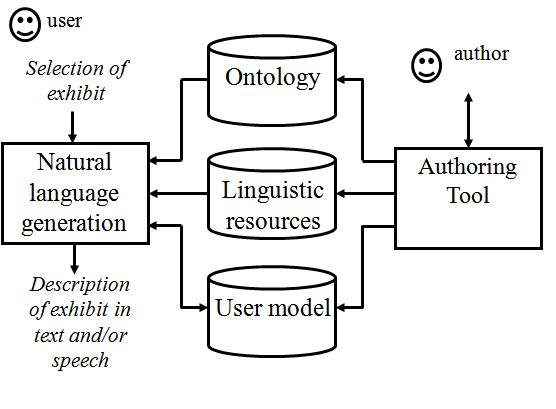ELEON
In the next figure, the usage of the ontology Authoring tool for natural language applications is depicted. The author with the aid of ELEON will define the domain ontology, and he will enrich it with lingustic resources, such as clause plans or microplans as well as a lexicon. In addition user models can be defined, which allow a further personalisation (for instance children, might prefer shorter sentences than adults). Finally, the above pieces of information which constitute ontology are exported in OWL (ontology) and RDF (lingustic resources and user models) formats. The resources will be used by a natural language generation engine to produce text. In particular, the next figure is influenced by an enchiched ontology for museum's exhibits, hence the label: "Selection of exhibit".
ELEON was designed and developed in the Software and Knowledge Engineering Laboratory (SKEL) of the NCSR "Demokritos". It was largely developed by Dimitris Bilidas.

Projects
Eleon has been used in the following national and European Projects: M-Piro, Xenios and Indigo
Relavant Publications
The next publication describes the capabilities of ELEON, in addition the user might be interested in the user's guide, available at the downloads section.
D. Bilidas, M. Theologou, V. Karkaletsis, "Enriching OWL Ontologies with Linguistic and User-Related Annotations: The ELEON System", Proceedings of the IEEE International Conference on Tools with Artificial Intelligence (ICTAI), Patra, Greece, 2007, (Available at: here)
D. Vogiatzis, D. Galanis, V. Karkaletsis, I. Androutsopoulos and C.D. Spyropoulos, "A Conversant Robotic Guide to Art Collections", Proceedings of the 2nd workshop on Language Technology for Cultural Heritage Data, Language Resources and Evaluation Conference (LREC 2008), Marrakech, Morocco, 2008